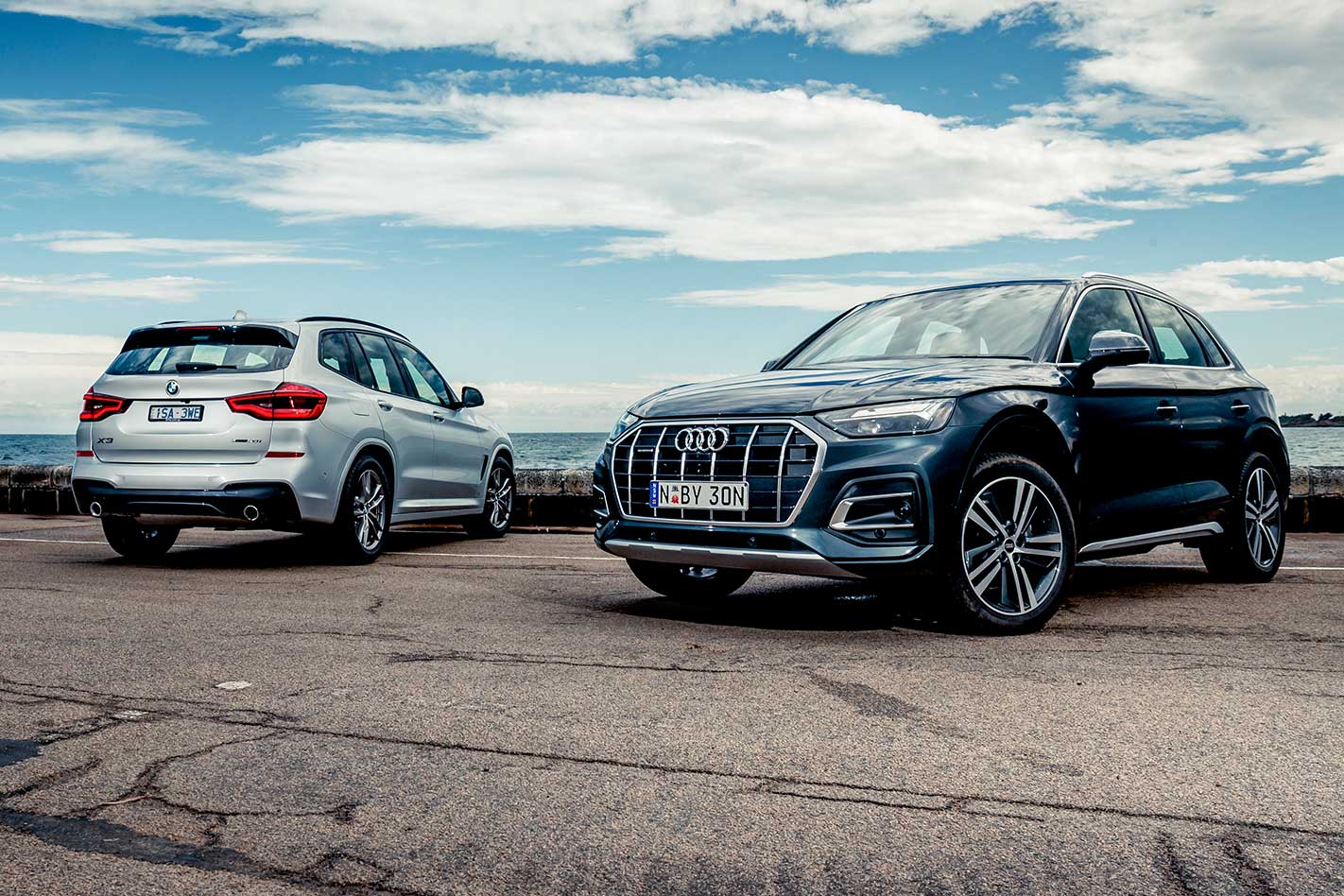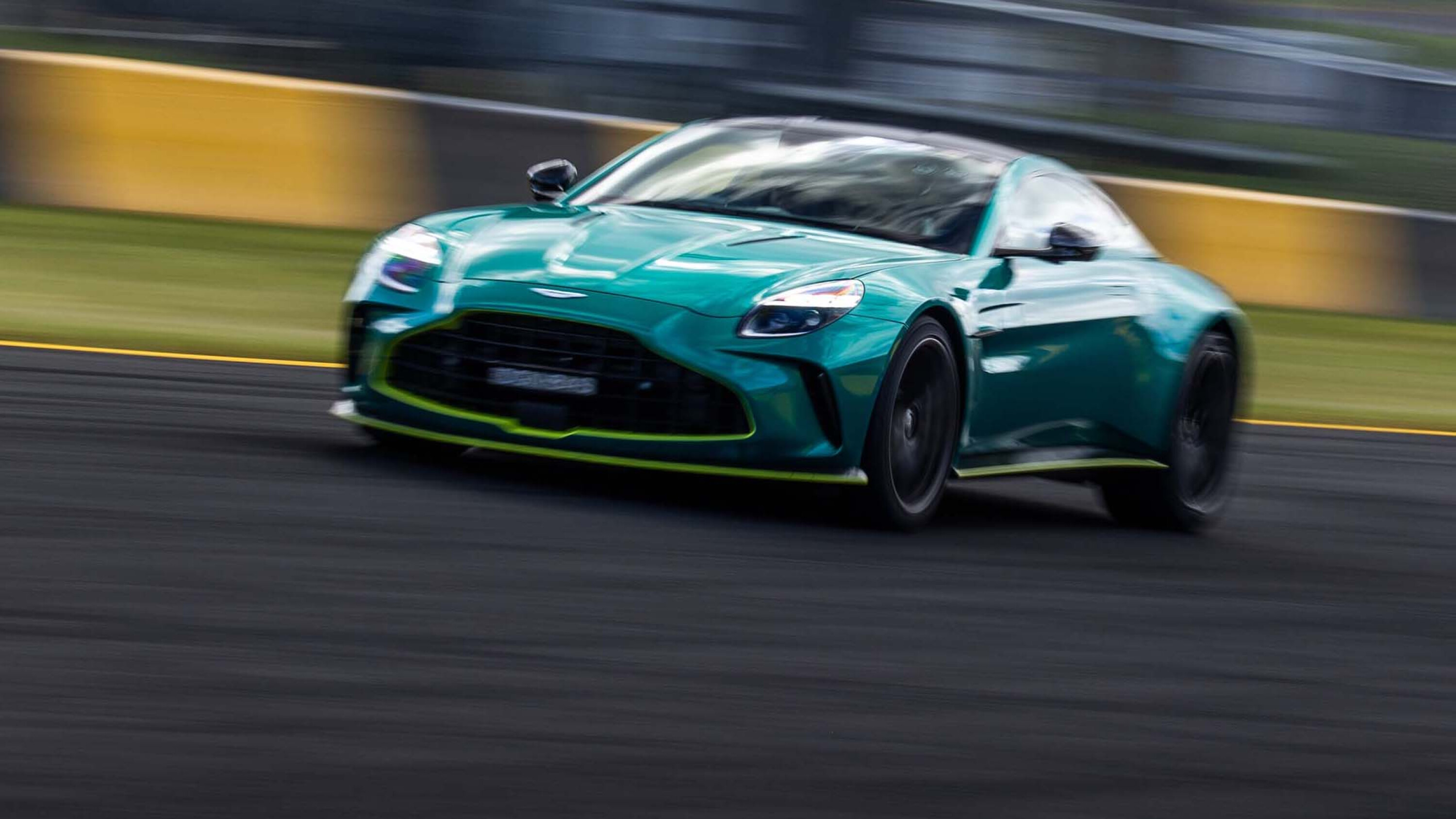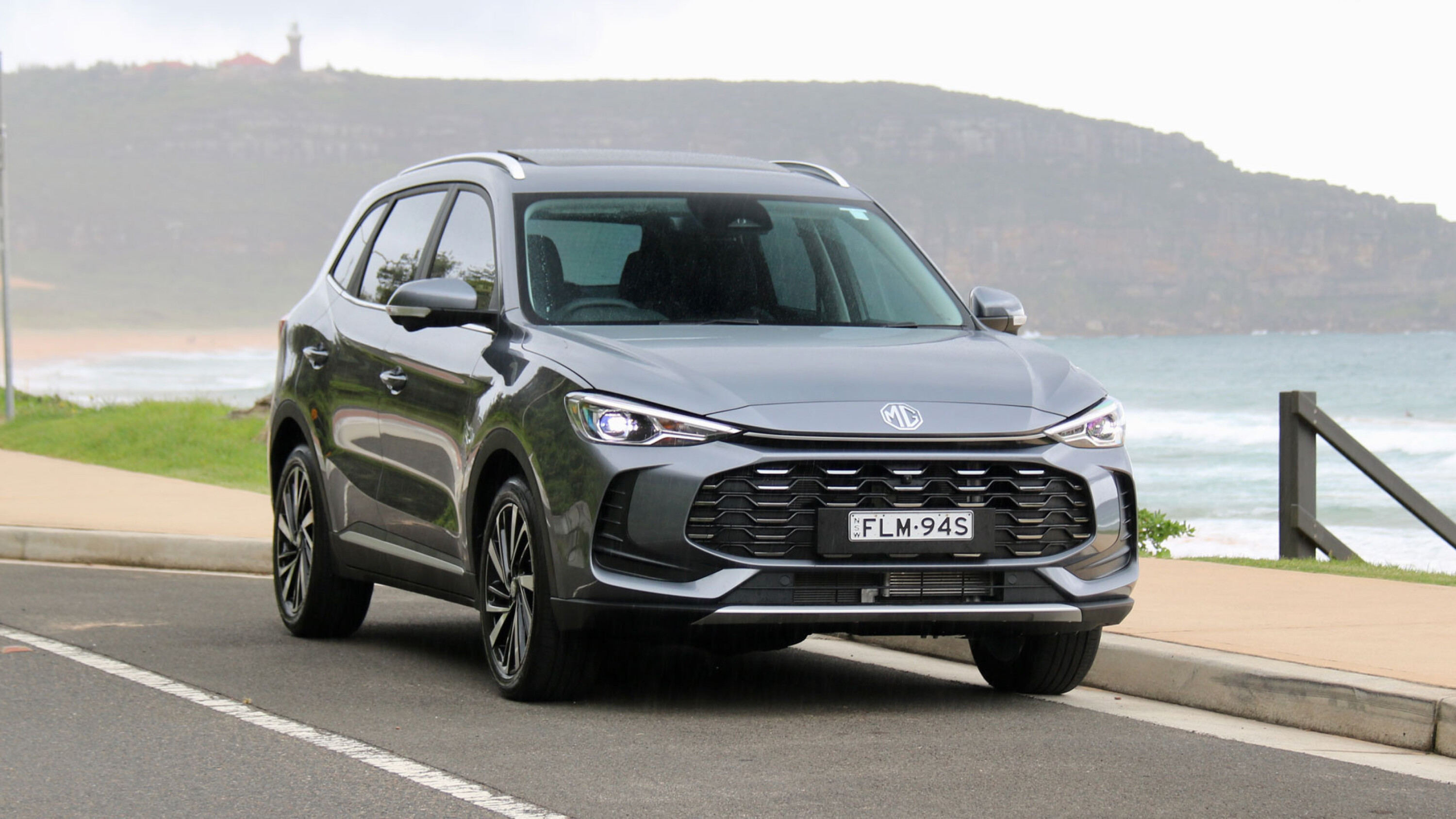Love ‘em or loathe ‘em, today’s luxury mid-sized SUVs like the Audi Q5 45 TFSI and BMW X3 30i are now as much a part of the story of us as any homegrown Holden or Ford. It just depends on where you are in life.
Thirty-odd years ago, with Ps in hand, maybe your choice – like mine – was between a Volkswagen Golf and Nissan Pulsar. A decade on, commitments might have meant a Mazda 6 or Toyota Camry (and a No Doz addiction), before the need for bigger stuff like a Ford Territory or Holden Captiva arose. Life’s great tapestry and all that.
Today – if you’re lucky – you’re middle aged (ish), middle class and in the market for a mid-sized premium SUV. You’ve made it this far, so why not? And before you think this is yet another instance of you turning into your parents, don’t forget: back in their day, a Ford Fairlane or Volvo 740 was likely in the mix. So maybe not.
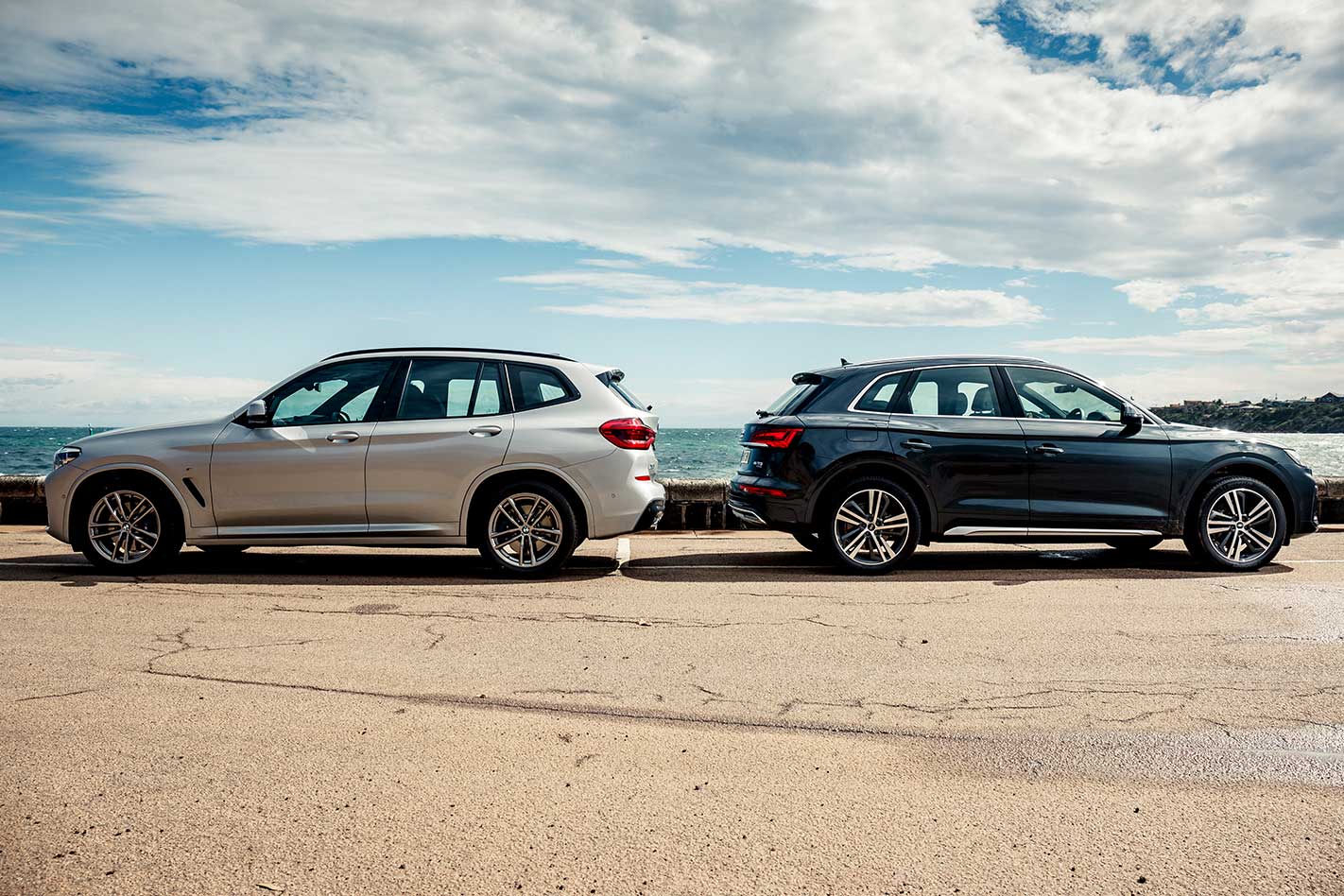
The latter’s interesting because it builds on an already-frugal proposition – up to 90kg was skimmed off when this current, B9 A4-based, second-generation, Type FY Q5 debuted in mid-2017.
Later that year was also when the third iteration of BMW X3 surfaced, though its mid-cycle nip ‘n tuck probably won’t happen before later this year at the earliest.
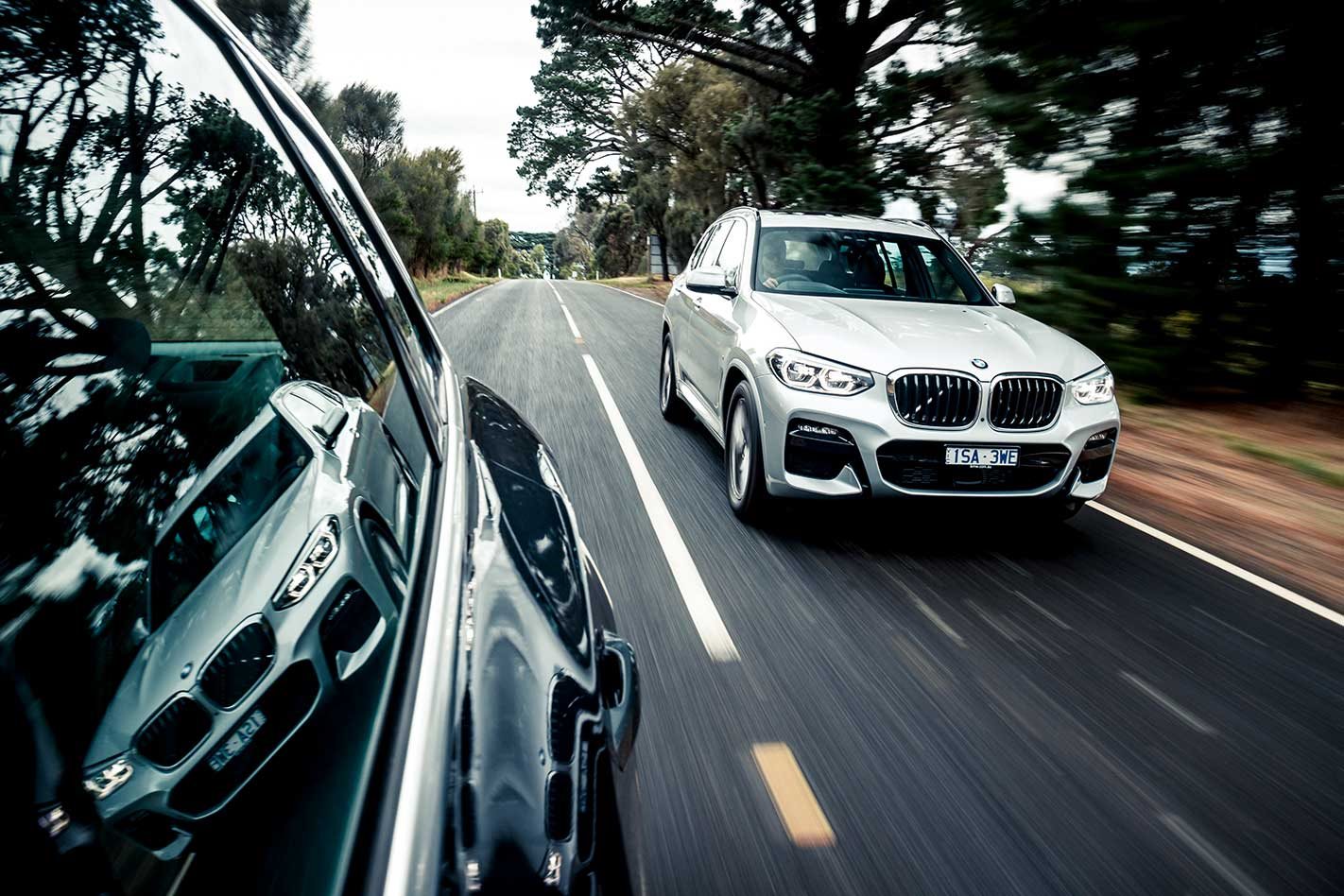
Classic Audi versus BMW stuff then. It’s like the old Holden versus Ford feud but for well-heeled folk. And on the subject of money.
Sledgehammer SQ5 aside, the 2021 Q5 is offered in five versions, with a trio of newly mildly-electrified internal combustion powertrain choices.
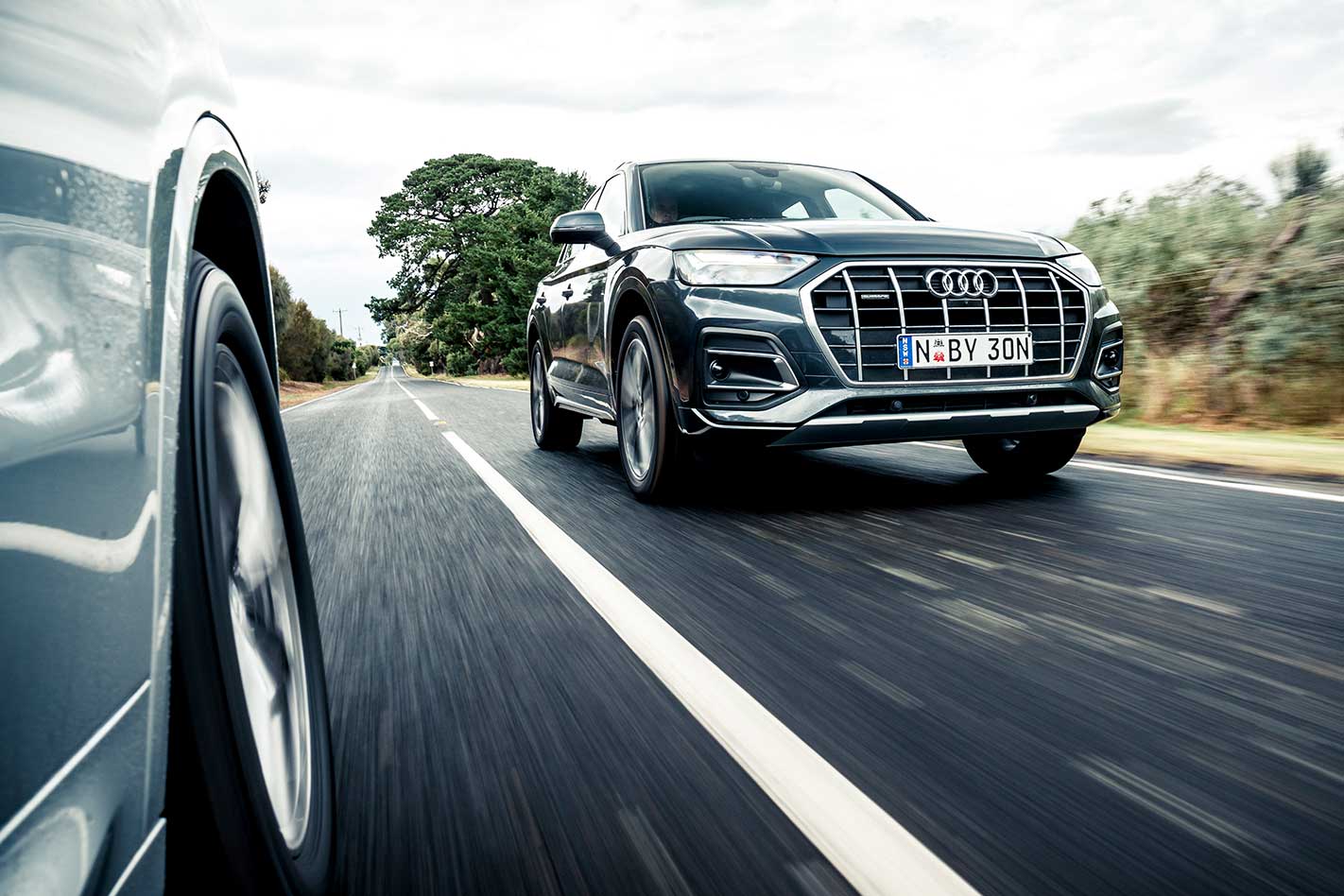
While these prices are around $2K dearer than before, the new $89,600 50 TDI S Line quattro is over $4500 exxier; it’s powered by a 210kW/620Nm 3.0-litre V6 turbo-diesel and employs an eight-speed torque-converter auto.
Safety is on a par with the class expectations, and includes Autonomous Emergency Braking (AEB), blind-spot monitor, lane keep warning and assist, Rear Cross-Traffic Alert, approaching traffic warning when turning right, hill descent control, parking sensors, tyre pressure monitor, driver attention monitor, reverse camera, auto headlights and rain-sensing wipers.
Also featured are keyless entry/start, Audi’s Virtual Cockpit digital instrumentation, ‘Hey, Audi’ speech control for the new 10.1-inch touchscreen multimedia, two-phone Bluetooth capability, Audi Connect real-time info connectivity, wireless Apple CarPlay/Android Auto, satellite navigation, digital radio, wireless smartphone charging, paddle shifters, leather upholstery, electric front seats, tri-zone climate control, ambient lighting, a powered tailgate with gesture control and alloy wheels.
Our 45 TFSI quattro is the better-equipped Sport, which adds adaptive cruise control and Traffic Jam Assist offering semi-autonomous driving, Collision Avoidance Assist, Turn Assist, a 360-degree view camera, automatic parking, a panoramic sunroof, sport front seats with heating and driver-side memory, a premium audio upgrade, heated/folding/dipping electric mirrors and 20-inch alloys – and all for an extra $7K.
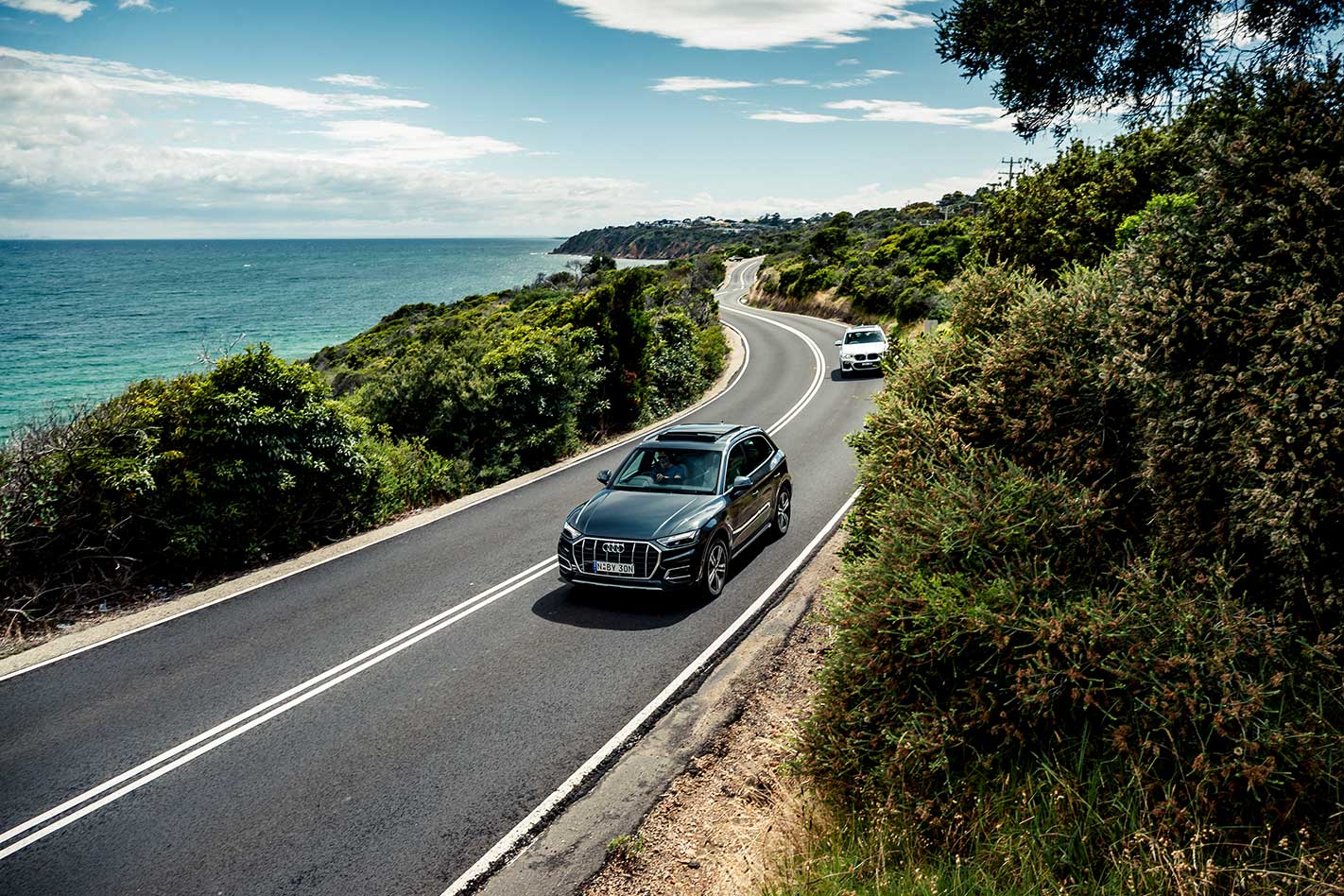
Meanwhile, the cheapest X3 petrol with AWD equivalent – the xDrive30i M Sport Pack – kicks off from $76,396 before ORC or $85,900 driveaway (nationally), and it too relies on a 2.0-litre four-pot turbo, with just 2kW more power at 185kW but 20Nm less torque at 350Nm than its four-ringed foe. The auto is ZF’s eight-speed torque-converter unit.
The SUVs from Ingolstadt (but built in Mexico) and Munich (via South Africa) offer near-lineball pricing and equipment levels, except that the xDrive30i standardises adaptive dampers, a head-up display and an M Sport body kit, uprated brakes and racier trim package… but forgoes the 45 TFSI quattro Sport’s sunroof and banging stereo.
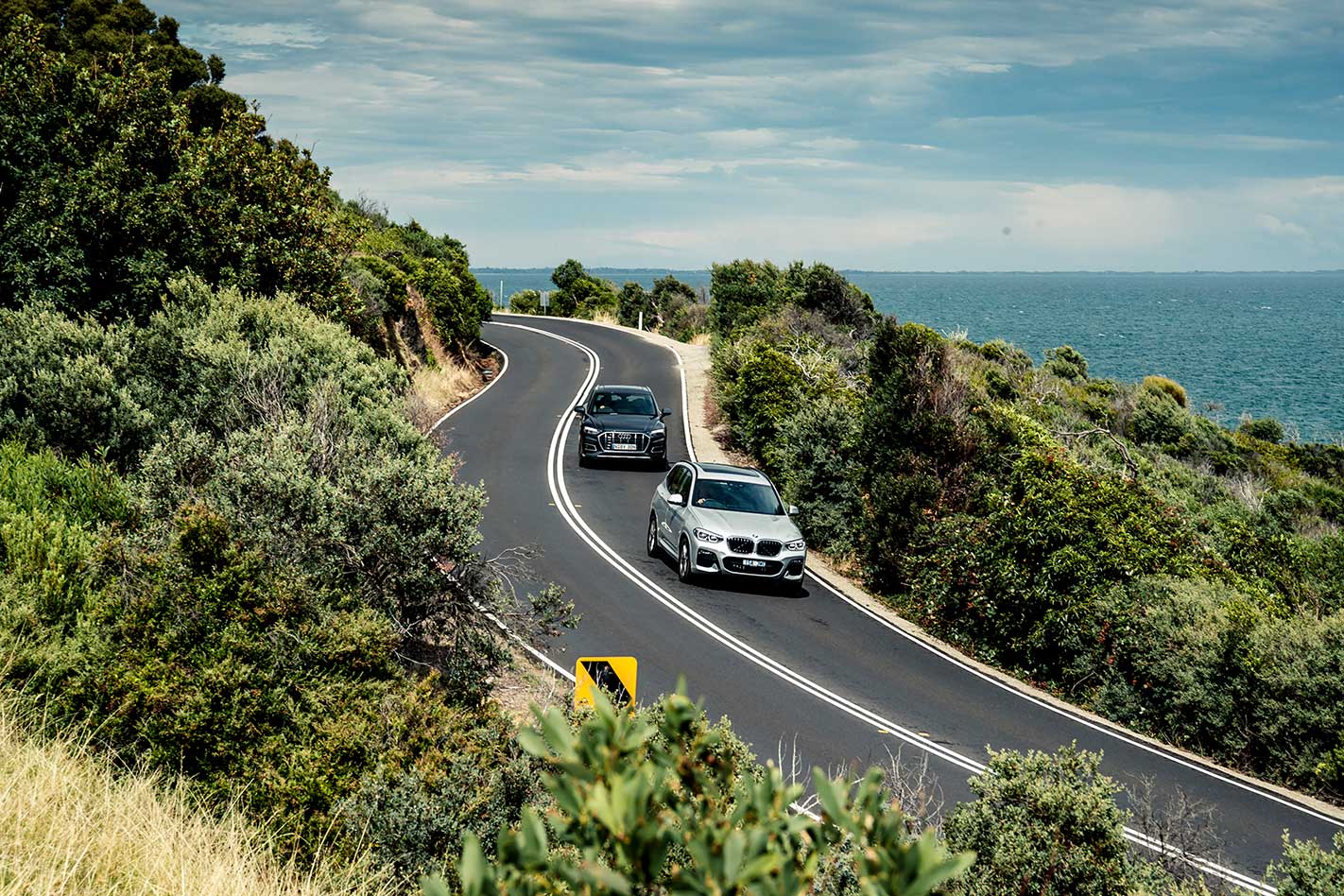
Replete in body-kitted activewear, both German SUVs look better than their base-grade brethren, though neither will be remembered for their beauty. The X3 in particular has always been the pretty X5’s fuglier baby bro. Fun fact: today’s G10 is larger than the original 1999 E53 X5.
As far as the post-purchase costs are concerned, a very interesting anomaly arises. Weighing in at 1825kg, the 45 TFSI quattro Sport’s official combined fuel-consumption figure is 8.0L/100km (for a carbon dioxide emissions rating of 182g/km), compared to the 1745kg xDrive30i’s 7.4L/100km and 169g/km. That disparity makes sense on paper given the mass differences.
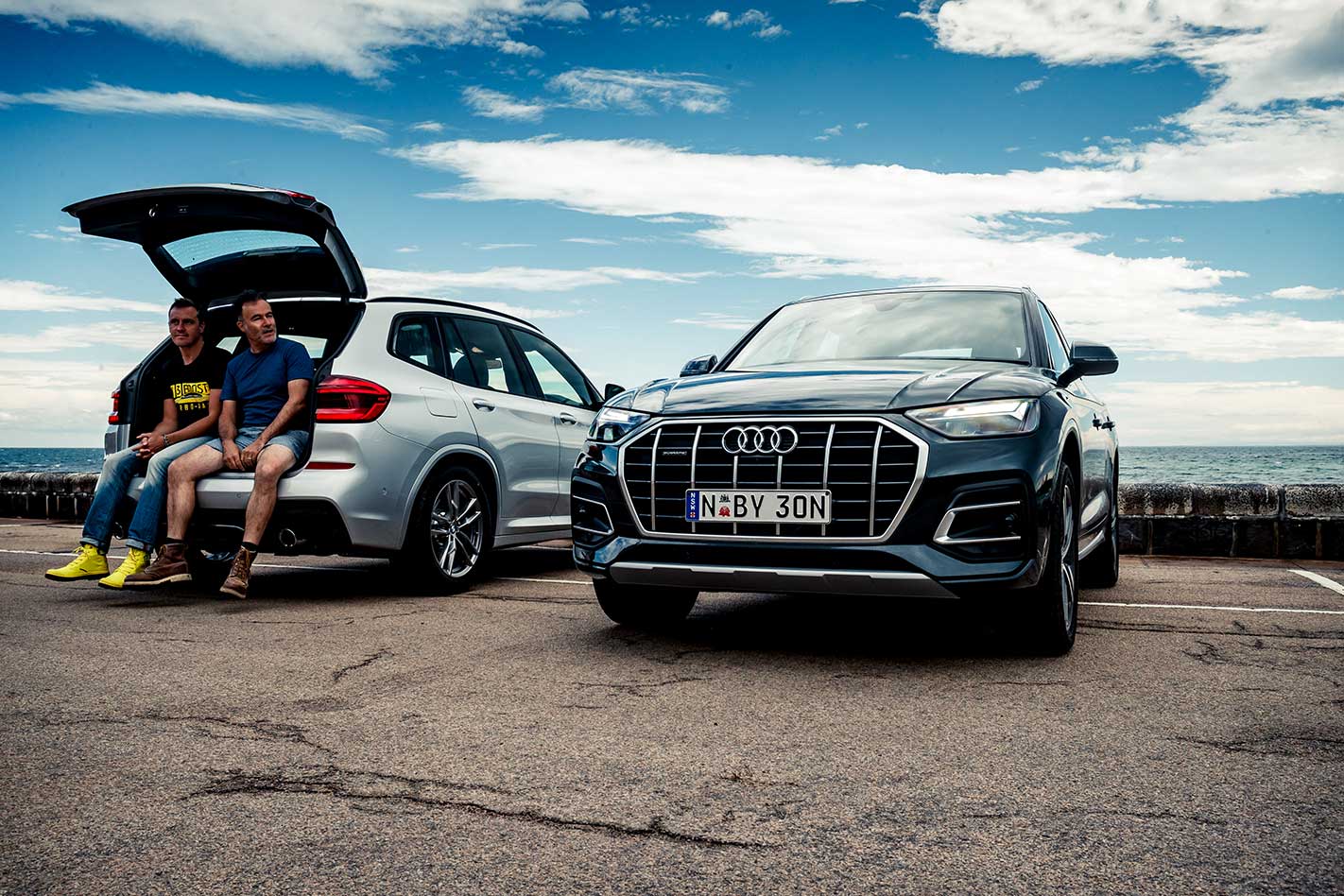
Audi’s 12-volt mild-hybrid tech and on-demand AWD system seem to more than offset the extra kilos. Unsurprisingly, 95 RON premium unleaded petrol is their preferred tipple.
Where both brands stumble is with their sub-standard three-year/unlimited-kilometre warranty, when rivals like Mercedes now offer five years.
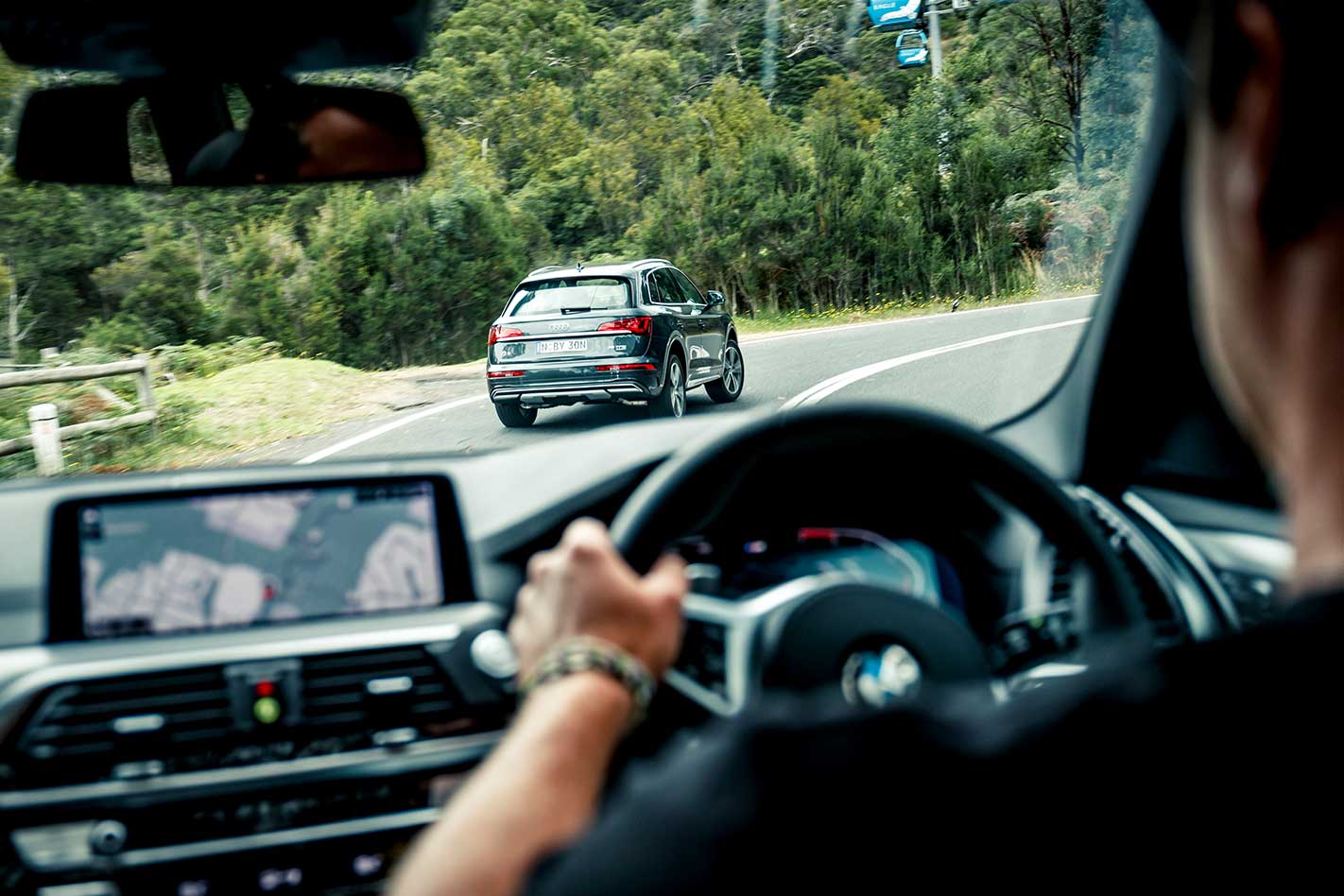
However, there is a ‘BMW Service Inclusive Basic’ package available starting at $1950, covering scheduled servicing from three-years/40,000km to five-years/80,000km.
After three years the 45 TFSI Sport quattro is expected to be worth about 61 percent of its value, behind the 63 percent forecast for the xDrive30i.
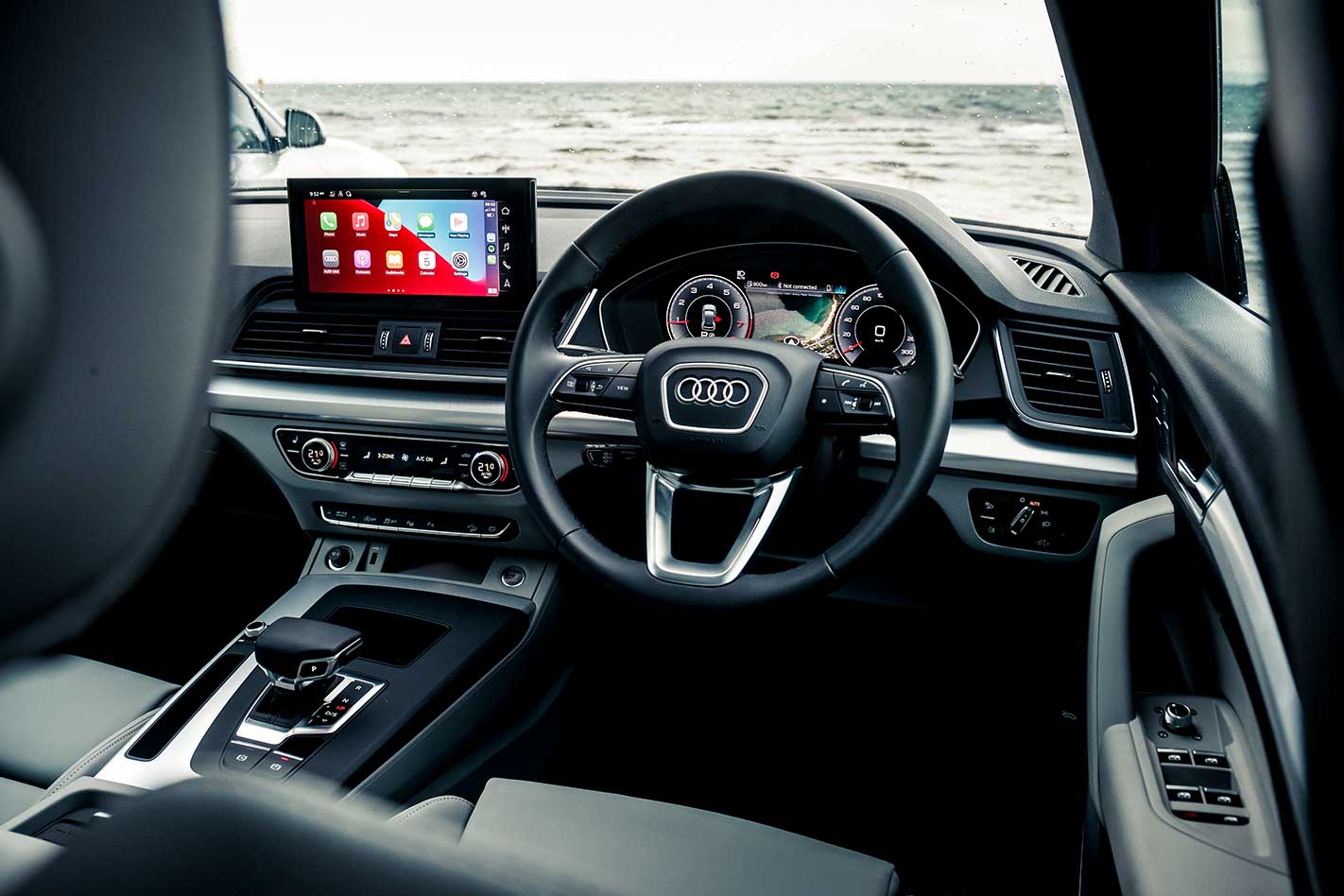
Making a mockery of their medium-size stationing, both SUVs are properly large inside, with ample room front and rear for a quartet of six-footers – as long as the trio out back are more Keira Knightley-sized than Newcastle Knights-like.
They’re remarkably similar in presentation too: doors open up wide for unencumbered entry/egress into solidly-made cabins; lofty seating includes big bolsters up front to keep you nestled in tightly and comfortably; and the driving positions simply cannot be faulted, such is their adjustability.
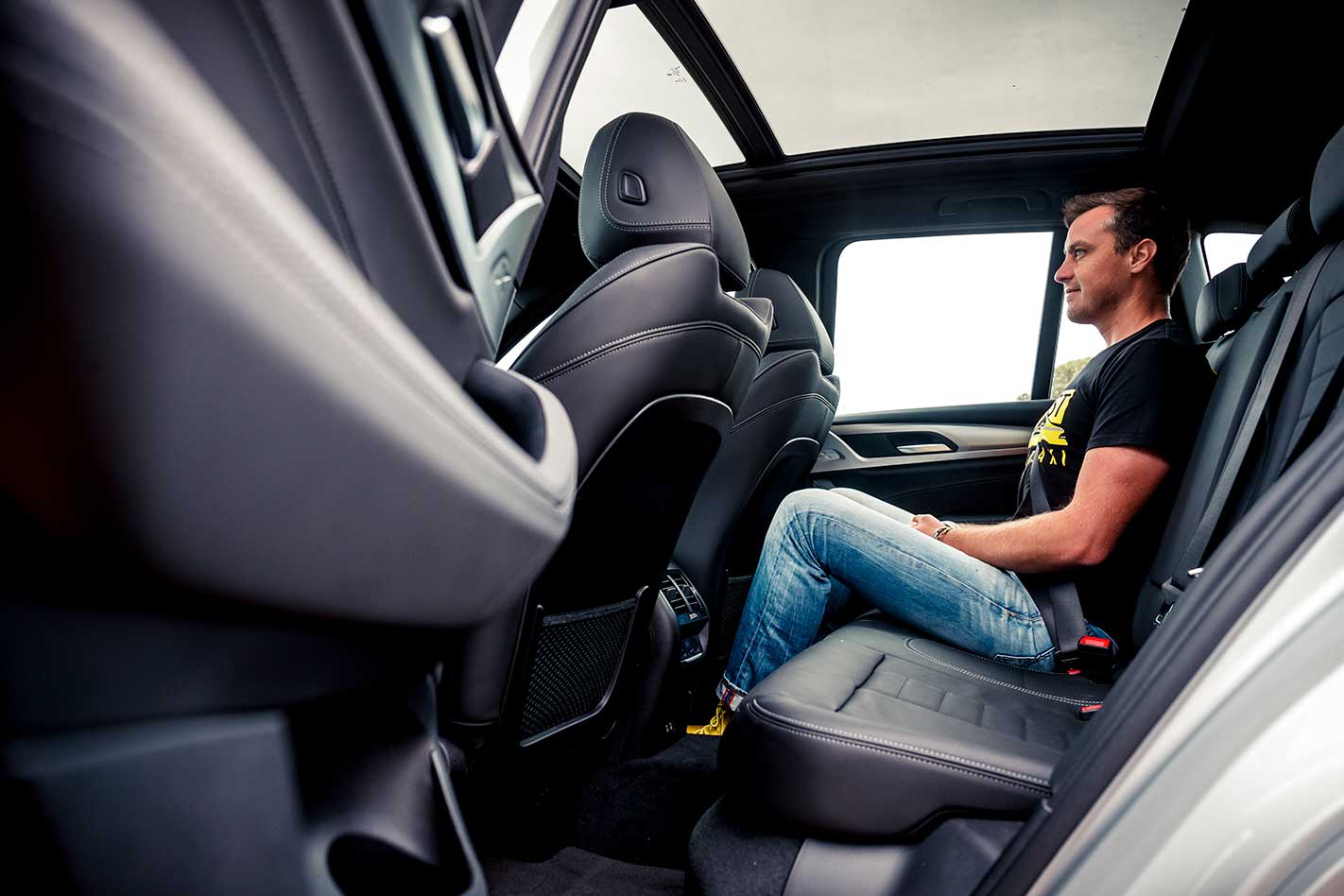
As mentioned earlier, even the equipment levels more-or-less align, as if they’re watching over each other’s’ shoulder. Surely the cheapo rear-armrest-sited cupholder arrangement that blights both cabins is proof.
If they were spying, Audi might be in for a shock. The X3’s dashboard is a modern masterpiece of presentation, melding the classic driver-angled display with sophisticated touchscreen tech.
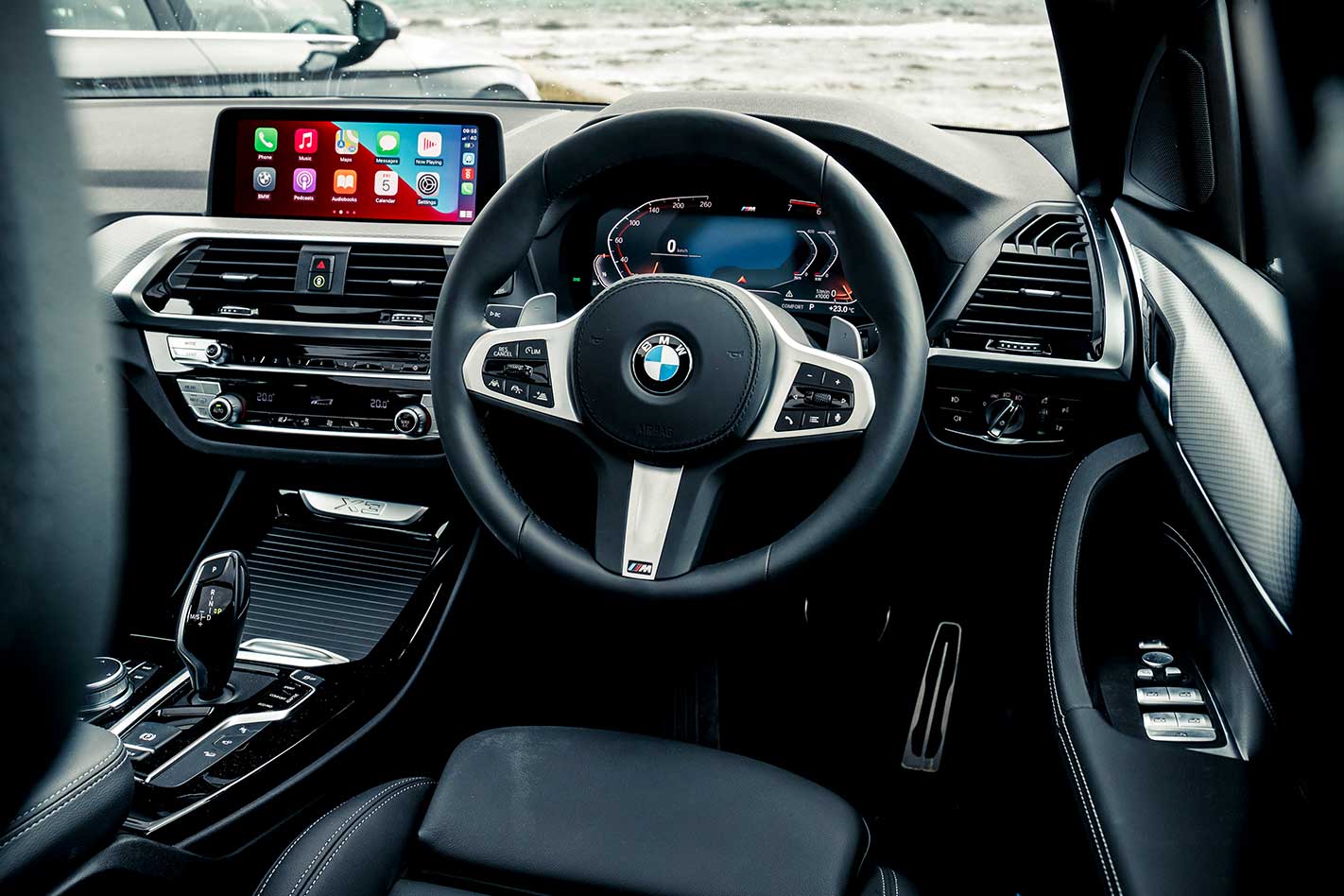
The gear lever is perfectly positioned and with the tip-shift function set up in the correct pull-upshift/push-downshift pattern. Our only disappointments are the messy electronic instrumentation – oh how we long for the elegant analogue dials of old – and surprisingly low-rent lower-lying plastics.
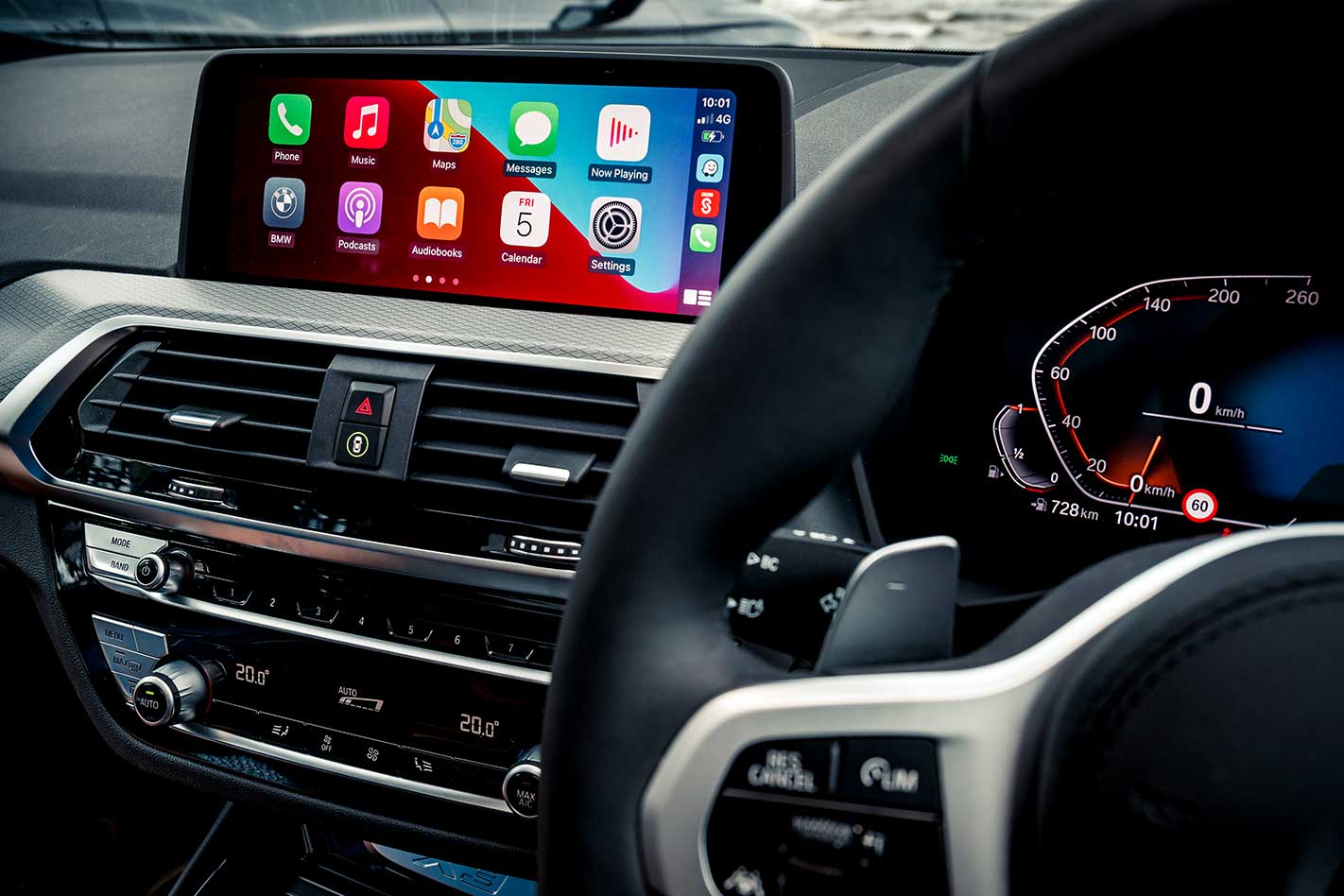
And the brand-spanking multimedia set-up is largely touchscreen-operated, but the clarity, logic and speed of response doesn’t make that a problem.
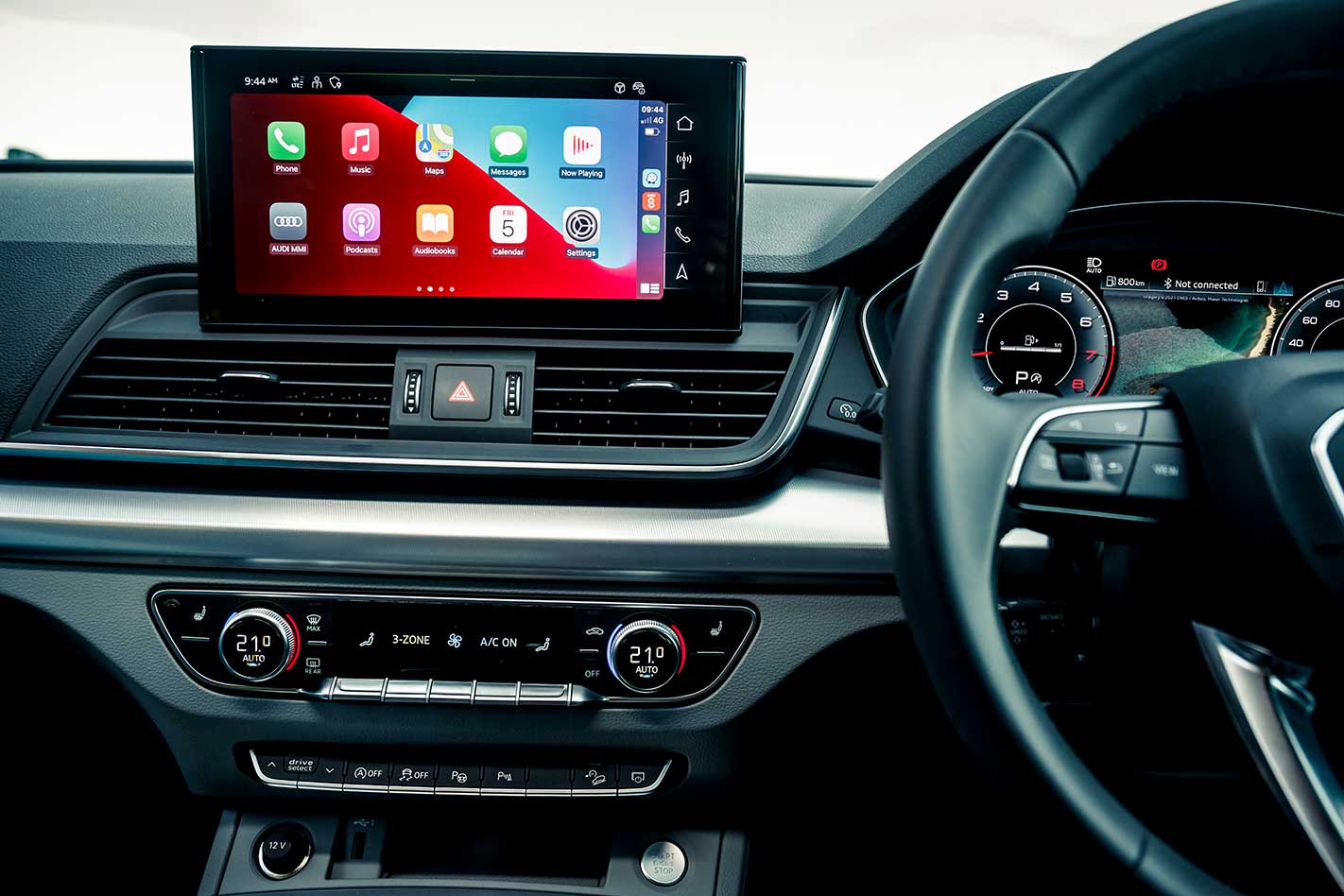
Further back, each provides family summer holiday levels of cargo capacity – the Q5 ranging from 520 litres to 1520L with the 40/20/40 backrest folded. The X3’s is even more cavernous, extending from 550L to 1600L, and with a spring-loaded remote fold-down backrest function to boot.
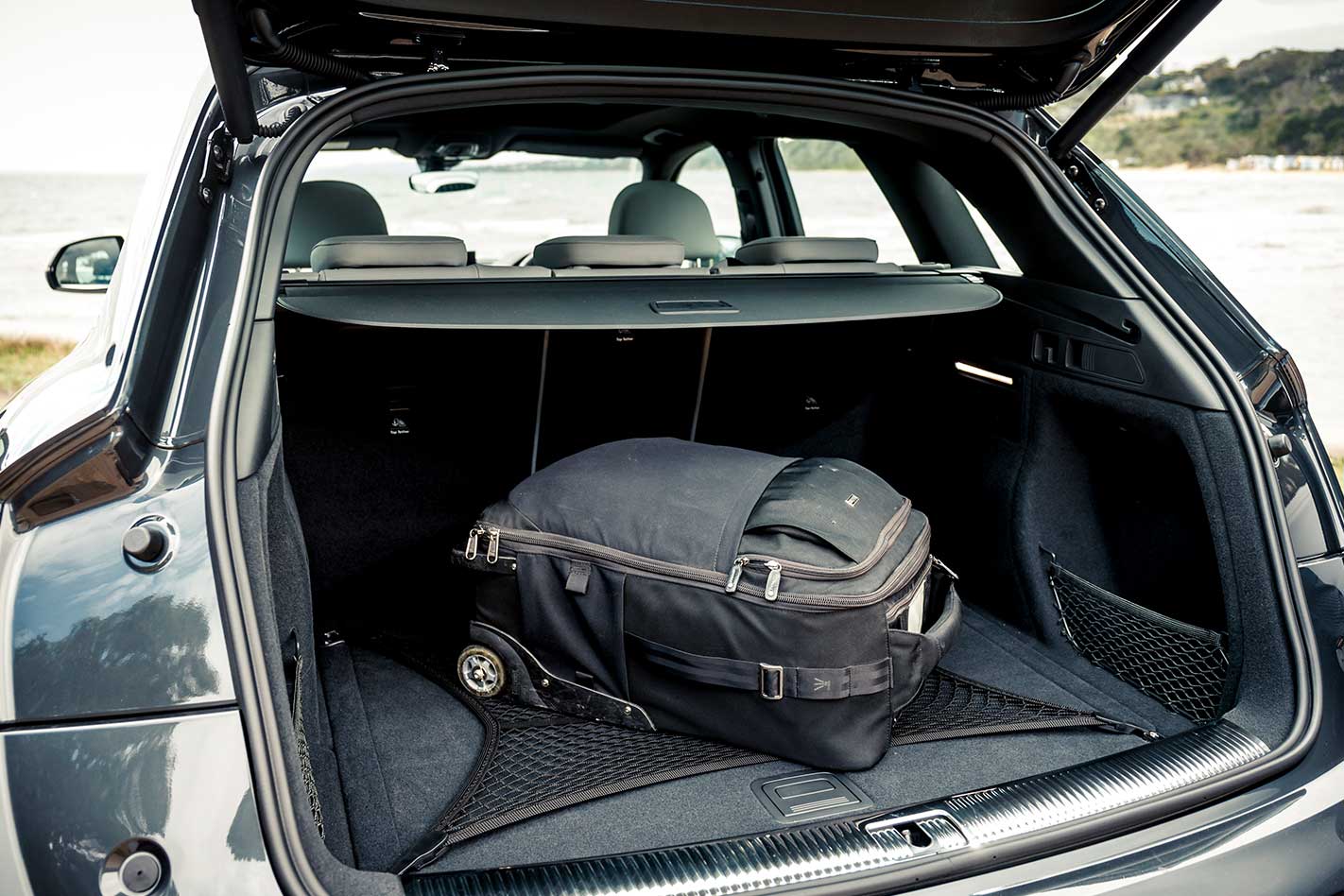
Speaking of security, shared active safety tech include AEB with pedestrian detection, blind-spot monitor, lane keep warning and assist, Rear Cross-Traffic Alert, approaching traffic warning when turning right, hill descent control, parking sensors, tyre pressure monitor, driver attention monitor, reverse camera, auto headlights and rain-sensing wipers.
Adaptive cruise control with stop/go capability, semi-autonomous parking, stability control, traction control, anti-lock brake, electronic brake-force distribution and brake assist are also present.

Both Germans were tested by Euro NCAP in 2017 and received the full five-star rating. To nobody’s surprise whatsoever, even their scores are practically identical, with the Audi achieving marginally better child-occupant protection and pedestrian impact ratings than the BMW.
Aided by the lofty seating position, low beltline and deep glass areas, all-round vision ranks highly in both vehicles, backed up by large mirrors and the big-screen reverse camera with alternative view options. Both SUVs also include a pair of rear-seat Isofix anchor points and a trio of child-seat tether strap anchors.
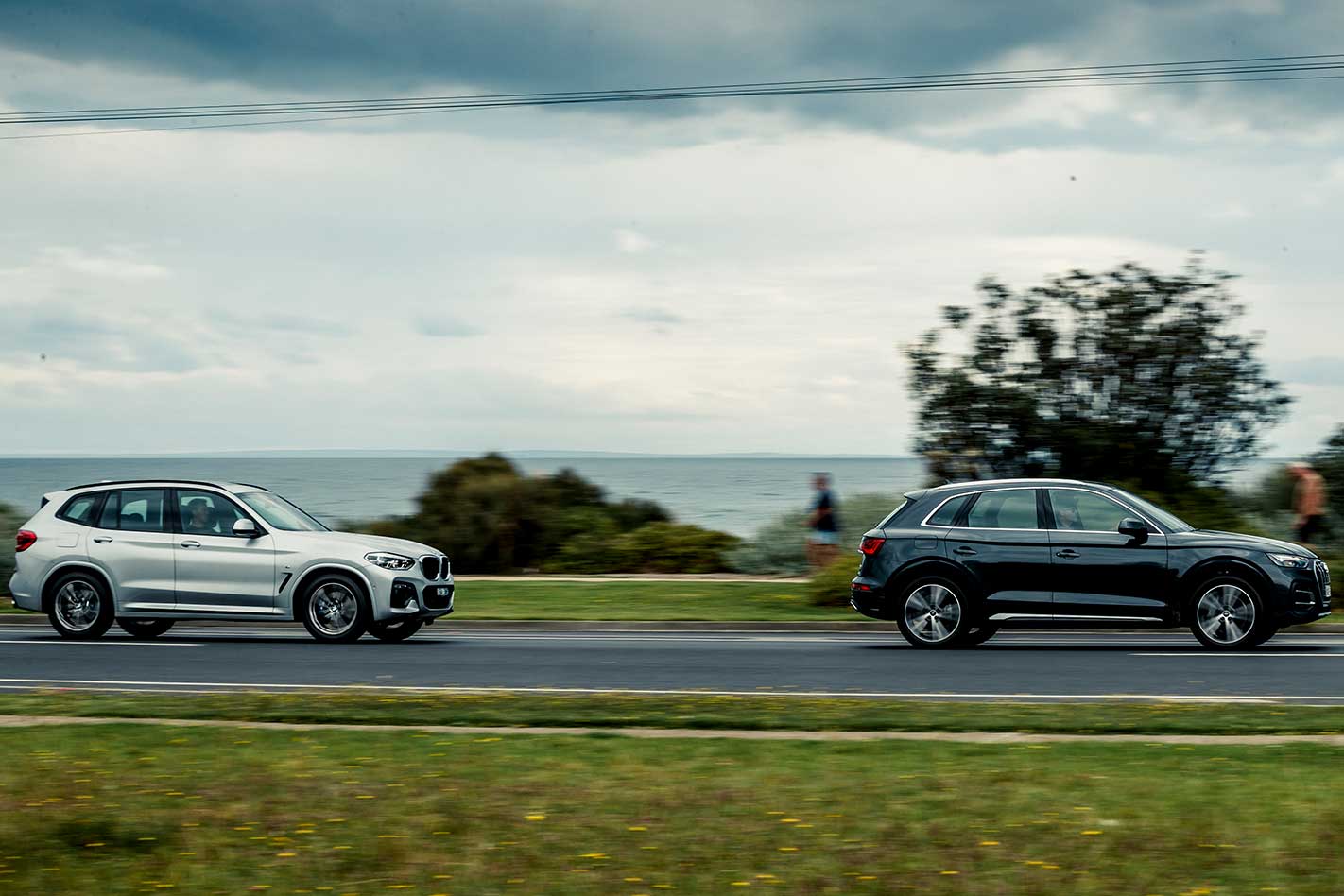
Audi first. The 183kW 2.0-litre four-cylinder turbo is a terrific engine even before you take its incredible economy potential into account. Punchy from the get-go, with very little of the lag or hiccup associated with dual-clutch gearboxes, it pulls as hard as it revs, tacho swinging swiftly and effortlessly to the redline without letting up.
It simply roars along. A metallic rasp betrays the comparative paucity of capacity, but this is no bad thing, imbuing the Q5 with a zingy, eager charm.

Ever responsive to throttle inputs, the xDrive30i’s flexes its muscles forcefully and yet fluidly every single time. What a gem.
The only thing missing is the mellifluous soundtrack of a classic BMW six. That’s a trade we’re willing to endure, as this 2.0-litre turbo’s ability to accelerate so vigorously from low revs is quite an achievement. Codenamed B48, it simply elevates this particular X3 grade in the process.
Initially, the Q5 feels faster, especially in Sport mode, but both return a 0-100km/h result of 6.3 seconds, while the X3 seems to have a deeper set of lungs at the top end, borne out by the 240km/h xDrive30i pipping the 45 TFSI quattro by just 3km/h.
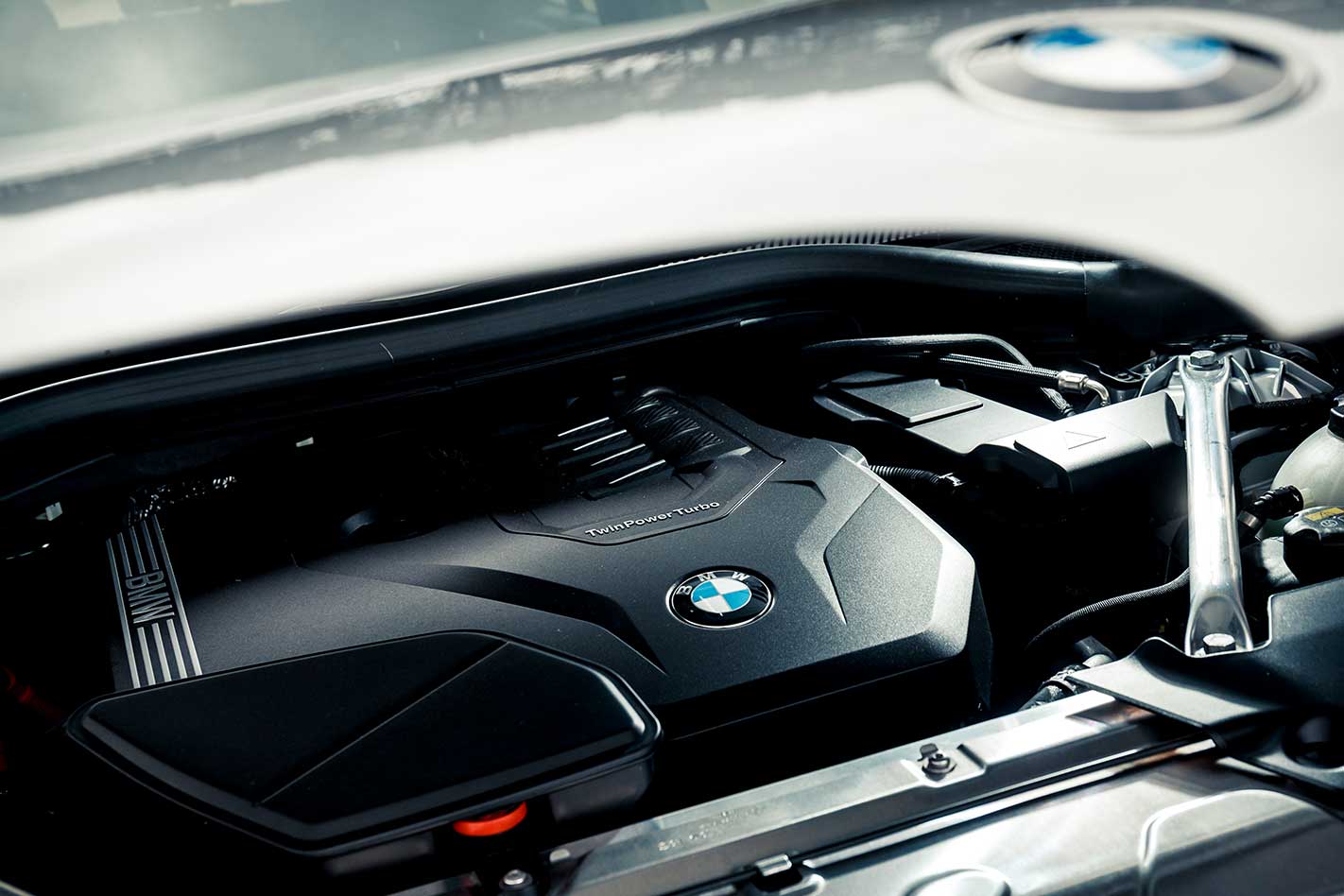
Another one of the Q5’s superpowers is its ability to relax and reassure new drivers. Climb in. Get immediately comfortable. Push the button, and off it goes, with an ease to its urge and a serenity to its speed that will instantly endear it to many people.
That sense of feeling light on its feet extends to the steering, which is effortless enough around town (and with a slightly better turning circle than the X3), yet precise and planted out on the open road, without becoming heavy or cumbersome.
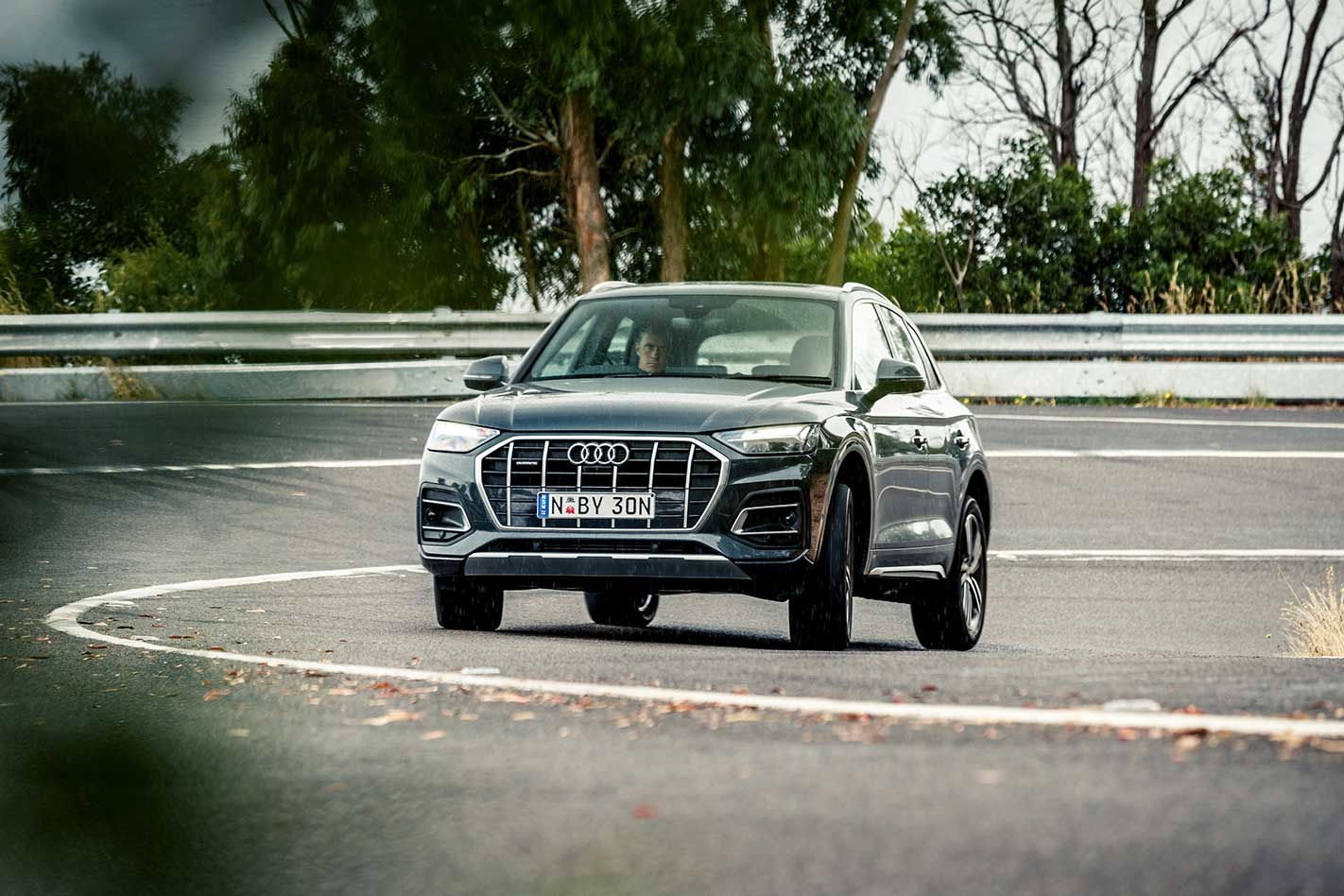
In contrast, the BMW feels palpably heftier and more solidly tied down to the road, from the first turn at low speeds through to blasting up a mountain pass. But it’s also in another class with the way it goes and flows with the road.
The xDrive30i’s standard Adaptive M Suspension with its adjustable dampers provide more nuance and finesse, backed up with greater feel and feedback.
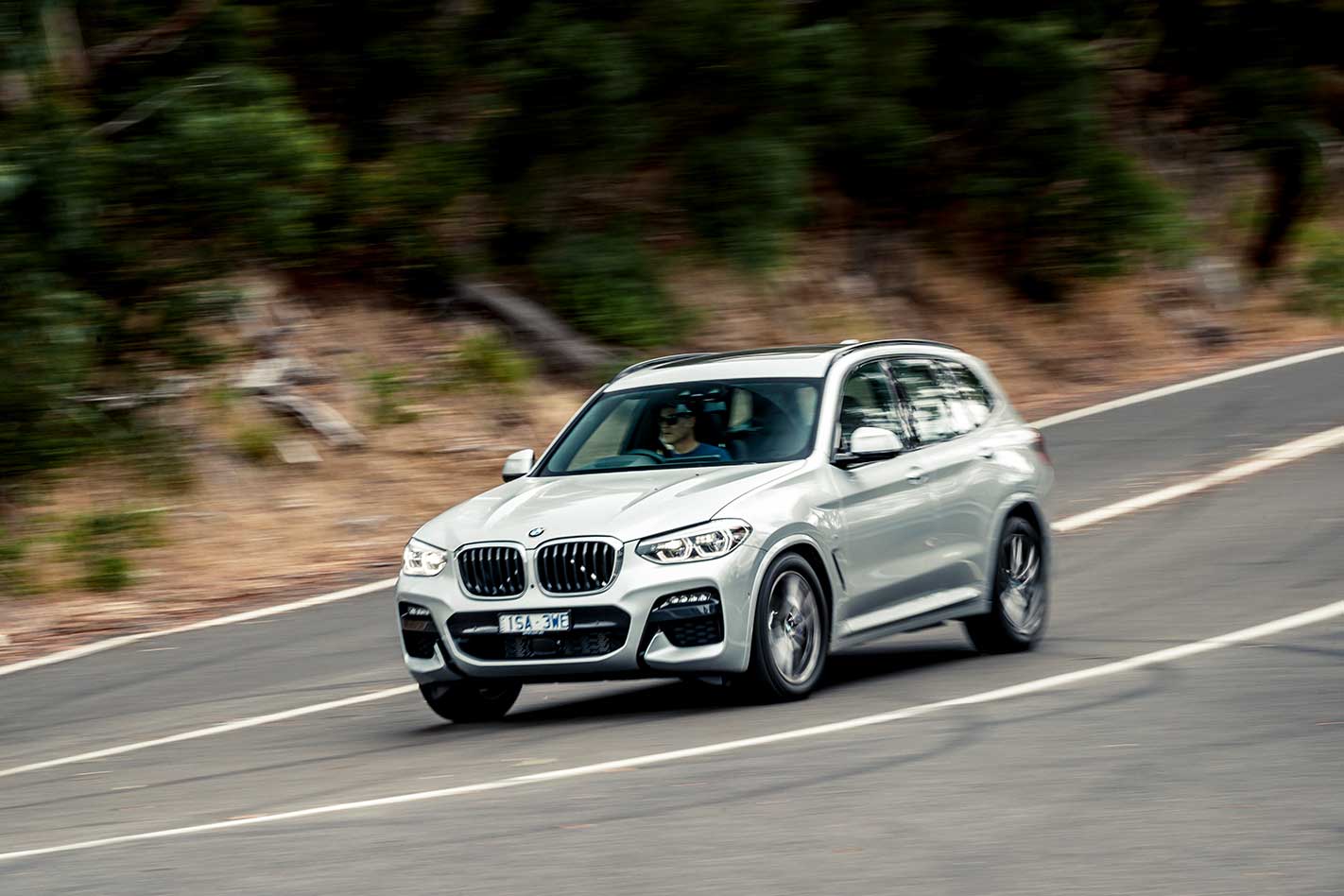
Conversely, the xDrive30i pulls ahead for ride comfort compared to the 45 TFSI quattro Sport, for two reasons – an inch-smaller wheels and those adaptive dampers.
The latter in particular reduce the amount of head toss out on the open road and suspension pitter patter around town, though it isn’t quite as quiet as the Audi either. For a bit over $2K extra, Q5 buyers can option up Adaptive Air Suspension – with variable ride height for greater ground clearance. Do it.
Note that BMW fits 20-inch alloys as standard on this grade, with the 19s as per our test car a no-cost option that probably makes the ride suppler. Sneaky.
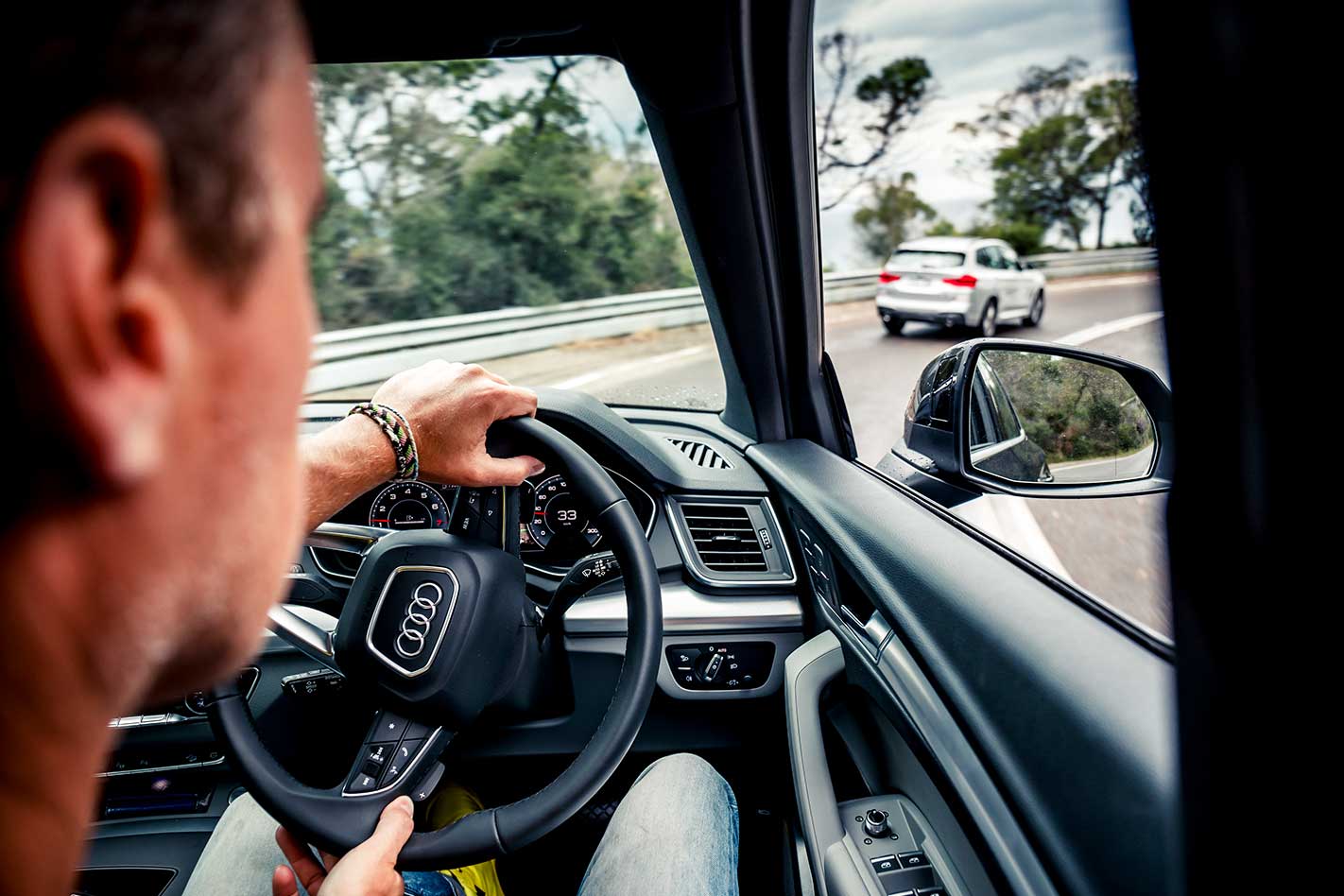
In searing Sport grades as tested, their premium is offset by matching high equipment levels, highlighting how eerily similar in execution the two German machines are.
In one area, however, the Audi is in a league of its own, and that is its mild-hybrid-enhanced fuel economy – and that’s even more impressive given how stirring its four-pot turbo performance remains. For some people, that’s enough to give the 45 TFSI quattro Sport a decisive advantage.
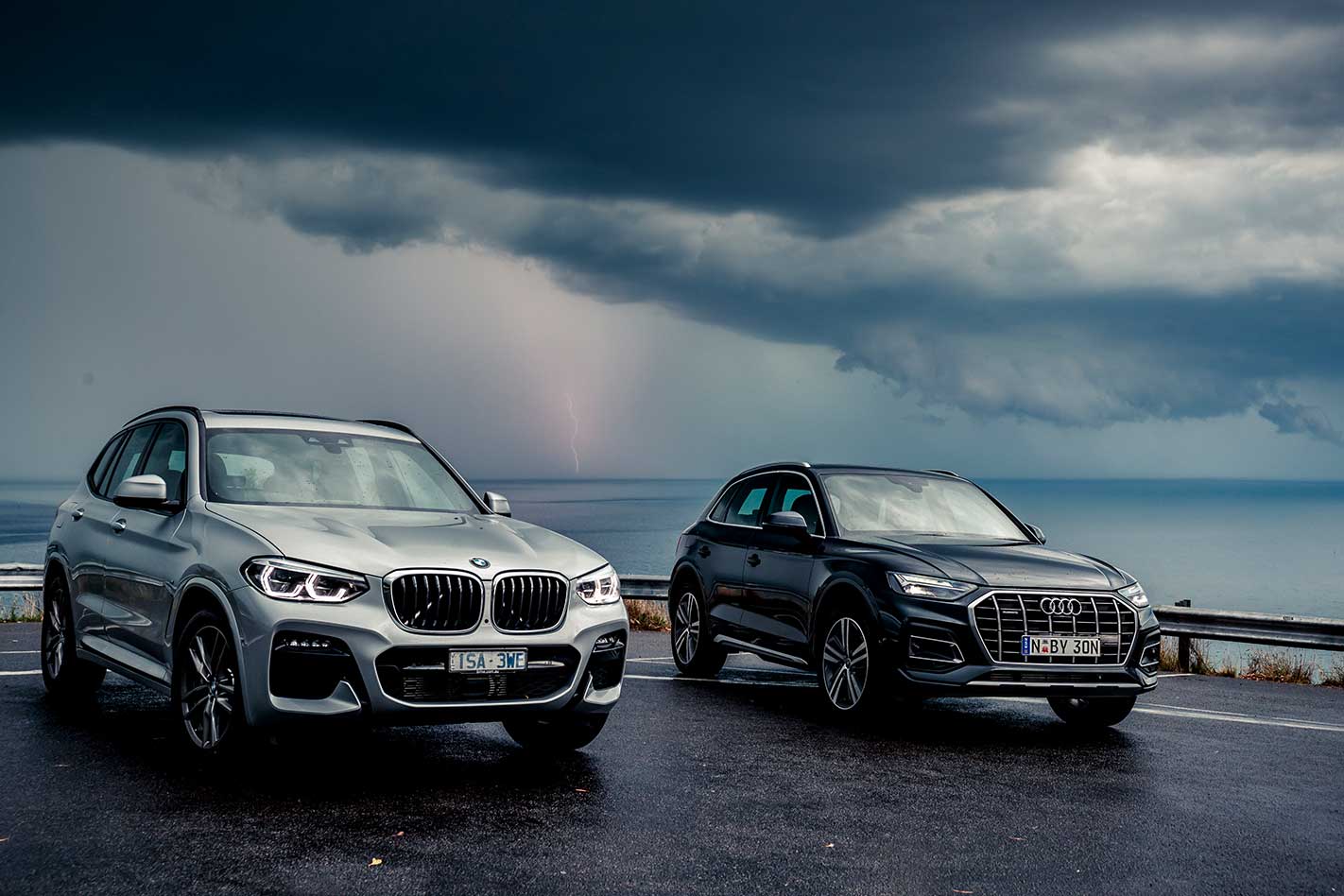
Which wins then? Your answer may already actually lay within: thinking back again to those earlier formative-years cars, would you have picked the Golf, Mazda6 and Territory over a Pulsar, Camry and Captiva? If the answer’s yes, yes and definitely yes, then the X3 is for you.
VERDICT
BMW X3 xDrive30i 1st
8/10
Pros: superb powertrain; impressive handling/ride balance; appealing dash presentation
Cons: dreary design; some cheap cabin materials; expensive options
Audi Q5 45 TFSI quattro Sport 2nd
7.5/10
Pros: outstanding efficiency; sparkling performance; spacious and quiet interior
Cons: not Audi’s best dash design; some cheap cabin materials; like BMW, sub-standard warranty
INTERIORS IN DETAIL
Audi Q5
Airy and uplifting it may be, with an obsessive approach to detail and quality as well as a new (MIB 3) info and multimedia system set-up, but the Q5’s dash is starting to look dated in 2021, and even a tad austere.

BMW X3
If you can see past the slightly chaotic instrument graphics, with their annoying digitised anti-clockwise tacho, the X3’s dash is almost flawless. Superb iDrive interface beats buttonless interface every time, while the M Sport package’s overall quality and ambience edges out Audi’s – even if both Germans suffer from cheapo lower-lying plastics.

Specifications
Audi Q5 45 TFSI Quattro Sport
Body: 5-door, 5-seat SUV Drive: all-wheel Engine 1984cc inline-4cyl, DOHC, 16v, turbo, mild hybrid Power: 183kW @ 5000-6500rpm Torque: 370Nm @ 1600-4300rpm Transmission: 7-speed dual-clutch Weight: 1825kg Power-to-weight: 100kW/tonne Fuel consumption: 8.9L/100km (tested) L/W/H: 4682/1893/1663mm Wheelbase: 2832mm Tracks: 1622/1626mm (f/r) Suspension: multi links, coil springs, anti-roll bar (f/r) Steering: electrically assisted rack-and-pinion Turning circle 11.7m (2.6 turns lock-to-lock) Brakes: 350mm ventilated discs (f); 330mm ventilated discs (r) Tyres: 255/45 R20 101W (f/r) Michelin Latitude Sport 3 Price: $76,600/As tested $78,590**
Warranty: 3yr/unlimited km. Service interval: 12 months, 15,000km. Glass’s 3-year resale: 61%. AAMI Insurance: $1170
BMW X3 xDrive30i M Sport
Body: 5-door, 5-seat SUV Drive: all-wheel Engine: 1998cc inline-4cyl, DOHC, 16v turbo Power: 185kW @ 6500rpm Torque: 350Nm @ 1450-4800rpm Transmission: 8-speed automatic Weight: 1745kg Power-to-weight: 106kW/tonne Fuel consumption: 12.7L/100km (tested) L/W/H: 4708/1891/1676mm Wheelbase: 2864mm Tracks: 1610/1594mm (f/r) Suspension: struts, A-arms, adaptive dampers, anti-roll bar (f); multi-links, coil springs, adaptive dampers, anti-roll bar (r) Steering: electrically assisted rack-and-pinion Brakes: 330mm ventilated discs (f/r) Tyres: 245/50 R19 (f/r) Bridgestone Atenza RFT Price: $76,396 /As tested $81,206**
Warranty: 3yr/unlimited km. Service interval: variable – condition based. Glass’s 3-year resale: 63%. AAMI Insurance: $1184

